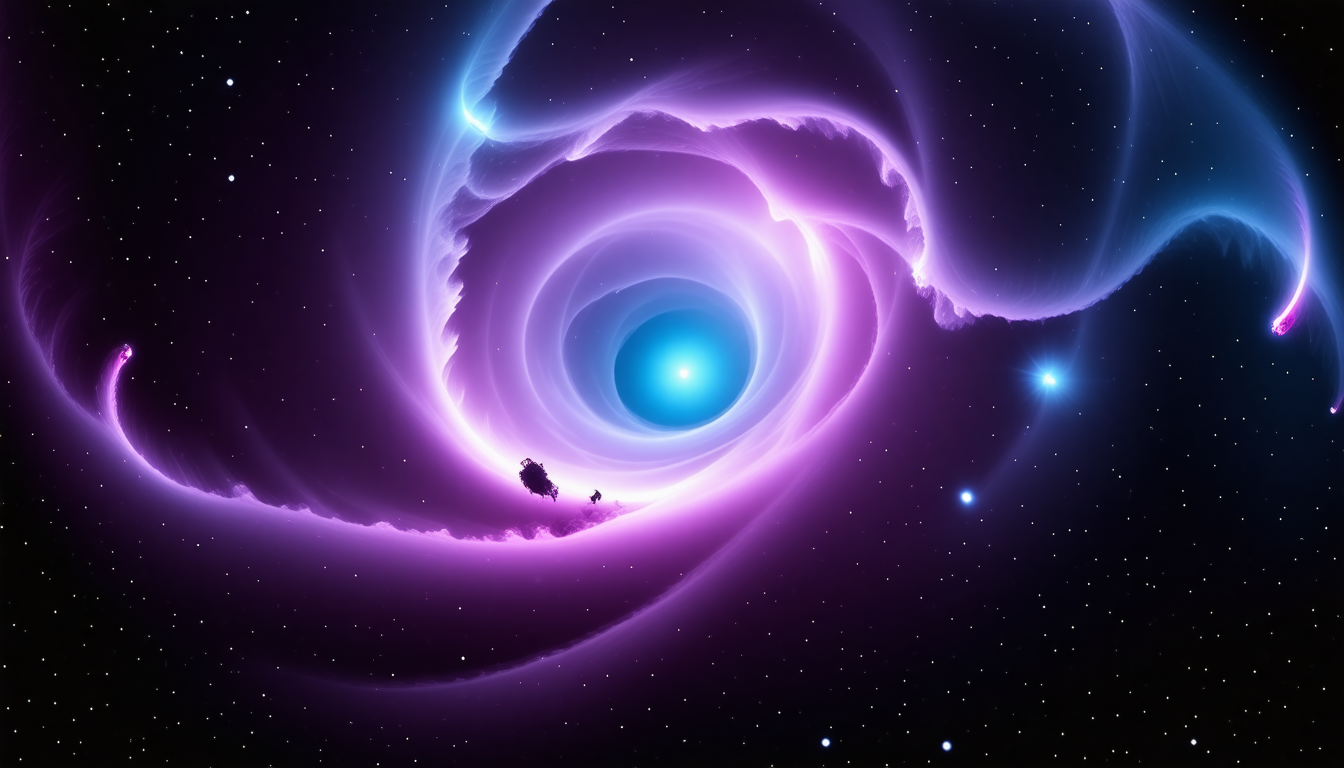Cosmic Evolution and the Quest for Extraterrestrial Life

The Origins of Our Universe and Cosmic Evolution
Imagine a universe so vast that it contains more stars than grains of sand on all the beaches of Earth combined. The Great Cosmic Tapestry is woven from threads of mystery, with each star and galaxy holding clues to our origins and the very nature of reality. At the heart of our quest for understanding lies the Big Bang Theory, the leading explanation for the inception of the universe itself.
Evidence for the Big Bang is not merely theoretical; it is supported by multiple lines of compelling data. Foremost among these is the cosmic microwave background radiation (CMB), a faint glow permeating the universe. This radiation is a remnant from the universe’s infancy, offering a snapshot of conditions when the cosmos was just a hot, dense soup of particles approximately 380,000 years old. The CMB was first discovered in the 1960s by Arno Penzias and Robert Wilson, whose hunt for noise inadvertently confirmed that the universe had a definitive beginning. This Afterglow provides scientists with a treasure trove of information about the early universe’s temperature, density, and structure, revealing the small fluctuations that would later seed the formation of galaxies.
Another cornerstone of support for the Big Bang Theory comes from the idea of redshift. When we gaze at distant galaxies, we observe that their light shifts toward the red end of the spectrum—an indication that they’re retreating from us. This phenomenon tells us that the universe is expanding, and if we play this expansion in reverse, we can surmise that all matter once existed in a singular, incredibly dense point in the past. This foundational idea aligns perfectly with the conditions predicted by the Big Bang Theory, promoting a vision of dynamic cosmic evolution.
The intricate dance of cosmic evolution is further illustrated by the concept of nucleosynthesis, which refers to the creation of new atomic nuclei. During the first few minutes after the Big Bang, the universe was too hot for atoms to form. However, as it cooled, protons and neutrons combined to create the lightest elements—primarily hydrogen and helium, with traces of lithium. The ratios of these primordial elements in our universe today closely match predictions made by the theory, reinforcing our understanding of how structure emerged from the early chaos.
As the universe continued to evolve, galaxies formed from these primordial materials. Observations reveal large-scale structures of the universe and how galaxies are distributed. The formation and clustering of galaxies echo the gravitational interplay of dark matter, an unseen but influential component that acts like cosmic scaffolding, shaping the universe’s structure. Without dark matter, our universe would appear unrecognizable, with far fewer galaxies and a chaotic arrangement of cosmic matter. Each new galaxy cluster that we observe expands our understanding of how gravity played an integral role in this grand cosmic ballet, leading us from a hot, dense state to the magnificent structures we see today.
The journey of cosmic evolution did not unfold uniformly. Thanks to the Inflation Theory, we now know that just moments after the Big Bang, the universe underwent a ferocious expansion—a rapid inflation that smoothed out irregularities and set the stage for the uniformity we observe today. This theory posits that the universe expanded faster than the speed of light, leading to a distribution of matter that we can analyze through the lens of the CMB and by studying the large-scale structure of present-day galaxies.
As we venture deeper into the cosmos, each discovery not only uncovers the secrets of cosmic evolution but also sparks profound questions about our origins and place within the universe. The mysteries of the universe resonate not just with scientists but with anyone who gazes up at the stars, inviting us to consider how everything we know threaded together through time and space. From galaxies being born to planets silently circling distant stars, every clue presents an opportunity for wonder, inspiring hopes of uncovering the ultimate truths of our existence.

The Nature and Impact of Dark Matter and Dark Energy
The universe is a remarkable tapestry, woven not only from the visible matter that gives rise to stars and galaxies but also from the mysterious substances known as dark matter and dark energy. Together, these elements compose roughly 95% of the cosmos, yet they remain elusive to direct observation. Consequently, scientists have dedicated themselves to deciphering their nature and understanding their profound implications for cosmic structure and evolution.
Dark matter, a mysterious component of the universe, cannot be observed through traditional electromagnetic means—i.e., it does not emit, absorb, or reflect light. Yet, its presence can be inferred from the gravitational effects it exerts on visible matter. For instance, when we observe the motion of stars within galaxies, they move in a manner that suggests a significant amount of additional mass, well beyond what we can see. This unseen mass gives structure to galaxies; it acts as a sort of glue that keeps these celestial bodies in intricate patterns, preventing them from flying apart due to their high rotational speeds.
One of the key pieces of evidence for dark matter’s existence comes from studying galaxy clusters. When astronomers analyze how galaxies move within these clusters, they find that the velocities indicate much more mass than that accounted for by the visible stars and gas alone. This discrepancy points to the presence of dark matter, which appears to make up about 27% of the total energy density of the universe. Such findings not only enhance our understanding of galaxy formation and clustering but also spotlight the fundamental role dark matter plays in shaping the large-scale structure of the cosmos.
In addition to dark matter, dark energy has surfaced as another enigmatic force that profoundly impacts the universe. While gravity acts to pull matter together, dark energy seems to work against this attraction, driving the accelerated expansion of the universe. The discovery of dark energy emerged from the observation of distant supernovae, which revealed that instead of slowing down due to gravitational forces, the universe’s expansion is indeed speeding up. This acceleration has ushered in theories and discussions surrounding dark energy, a substance thought to make up about 68% of the total energy content of the universe.
Dark energy’s nature remains one of the most significant puzzles in state-of-the-art cosmology. One predominant hypothesis proposes that dark energy acts as a cosmological constant—a uniform energy density that fills space homogeneously. As space expands, the energy density of dark energy remains constant, perpetuating the universe’s rapid expansion. Alternatively, some theories suggest that dark energy could vary over time, introducing new dynamics into the equations that govern the evolution of the universe.
As we endeavor to unveil the mysteries surrounding dark matter and dark energy, we inch closer to understanding the ultimate fate of the universe itself. Various scenarios have emerged, leading to potential outcomes based on the interplay of these elusive forces. If dark energy continues to dominate, we may face a universe that expands forever, drifting toward a cold and desolate state known as “heat death.” Conversely, should gravitational forces associated with dark matter begin to overpower dark energy, the universe could eventually contract, culminating in a “Big Crunch” scenario.
A further implication of dark matter and dark energy is their effect on our understanding of the cosmos’ geometry. By studying the distribution of these components, scientists can infer whether the universe is flat, open, or closed. Current observations suggest that the universe is flat on large scales, which aligns with our understanding based on inflationary theory. This connection illustrates how deeply intertwined the concepts of dark presence are with our broader comprehension of cosmology, reflecting on questions of existence, structure, and even the philosophical inquiries surrounding what it means to be a part of this expansive universe.
Thus, dark matter and dark energy serve not merely as abstract concepts but as gateways into exploring profound questions central to our existence. In grappling with their nature, we are compelled to confront the larger mysteries of the universe, fueling our quest for knowledge, inspiring curiosity, and igniting a deeper appreciation for the complexities of the cosmos that surrounds us. Each discovery and piece of evidence pushes us forward, challenging us to rethink everything we know about the universe and our place within it, urging us—forever seeking more answers, more clarity, and a deeper understanding of the grand cosmic ballet unfolding around us.

Exploring Exoplanets and the Potential for Extraterrestrial Life
The search for exoplanets has ignited an unprecedented curiosity about the potential for life beyond our home planet. With the robust technologies available today, astronomers have discovered thousands of exoplanets, each bringing us closer to understanding the diversity of worlds that could exist beyond our solar system. Among the many facets of these discoveries, the idea of habitability has emerged as a pivotal theme in the quest to answer humanity’s age-old question: Are we alone in the universe?
The pursuit of potentially habitable exoplanets focuses significantly on their location within a star’s habitable zone, often dubbed the “Goldilocks zone.” This region is where the conditions are just right—not too hot and not too cold—for liquid water to exist on a planet’s surface, a vital ingredient for life as we know it. However, merely being in this sweet spot is not enough; scientists also examine the size and composition of these planets. Rocky planets—those that are larger than Mars but smaller than gas giants like Neptune—are qualified as prime candidates for hosting life. That’s largely due to their ability to retain an atmosphere, which can be essential for supporting biological processes.
To detect exoplanets, astronomers primarily employ the transit method, which involves monitoring stars for periodic dips in brightness, indicating that an orbiting planet is blocking a portion of its light. The Kepler Space Telescope has been instrumental in this endeavor, revolutionizing the field of exoplanet discovery and significantly increasing the known number of potential Earth-like worlds in our galaxy. Additionally, the radial velocity technique provides another avenue for detection by measuring the subtle “wobble” of a star caused by the gravitational influence of an orbiting planet. Observations from these methods have confirmed the existence of a remarkable variety of planetary types, including gas giants, super-Earths, and even rogue planets that wander through space without a parent star.
Among the most exciting aspects of exoplanet studies is the potential for finding life, or at least the conditions that sustain life. Analyzing the atmospheres of these distant worlds is critical in this quest. Using advanced spectrometers attached to ground and space-based telescopes, scientists can examine the light filtered through a planet’s atmosphere during transits. This analysis reveals the chemical composition, and the presence of biosignature gases—such as oxygen and methane—could indicate biological activity. Ongoing missions like the James Webb Space Telescope promise to enhance our ability to detect these signatures in exoplanetary atmospheres, potentially confirming the existence of life or prebiotic conditions.
Notably, the discovery of exoplanets also has profound implications for understanding our own solar system. By comparing these distant worlds with our planets, scientists can refine models of planetary formation and evolution. For instance, some gas giants are discovered closer to their stars than previously thought possible, challenging existing theories about the principles of planet formation. As we gather more information about diverse planetary systems, we may uncover the mechanisms that lead to the formation of unique environments, enriching our understanding of how life could arise on other worlds. Each new finding pushes the boundaries of what we know about planetary systems, revealing that the universe is a place of extraordinary complexity.
The implications of these discoveries extend well beyond the scientific community, sparking public interest and inspiring future generations. The idea that there could be billions of Earth-like planets orbiting stars in our galaxy encourages a sense of wonder about the cosmos and what it entails. Coupled with the search for biosignatures, the questions of whether life exists elsewhere or whether we are alone in the universe fuel a passion for space exploration and science. Every discovery of a new planet not only broadens our astronomical catalog but illuminates pathways for understanding our existence and what it might mean to be a conscious being within an expansive universe.
As we venture deeper into the cosmos, the quest to study exoplanets significantly enriches our narrative. Each new discovery invites us to reflect on our origins and the conditions necessary for life to thrive. Innovations in technology, rigorous scientific inquiry, and the exploration of new worlds together construct a cohesive story of hope and wonder. Ultimately, the exploration of exoplanets is not just about understanding the planets themselves; it’s about unraveling the mysteries of life, existence, and our place within the grand tapestry of the universe.
Challenges and Innovations in Space Exploration and Astronomy
As we push the boundaries of our knowledge through space exploration and astronomical advancements, we encounter a unique set of challenges that drive innovation and collaboration within scientific fields. The intricate journey of exploring the cosmos demands not only cutting-edge technology but also the ability to adapt and navigate unforeseen obstacles. For instance, the sheer distance of celestial bodies presents a formidable challenge. Missions to Mars take approximately six to eight months, while those targeting the outer planets like Jupiter and Saturn can span several years. Navigating these distances requires rigorous planning regarding spacecraft propulsion, energy management, and sustainable mission design.
Communication with spacecraft is another hurdle, as signals can take considerable time to reach their destinations. Transmissions to Mars can take around 13 minutes one way, leading to potential delays and a lack of real-time interactions. This necessitates that spacecraft be equipped with autonomous systems capable of making decisions without immediate input from Earth. Such technological advancements are crucial, as they allow scientists to adapt and respond effectively to rapid changes in conditions during long missions.
Additionally, harsh environments encountered in space require robust engineering solutions. Spacecraft must be designed to endure extreme temperatures, radiation, and micrometeorite impacts, all while functioning reliably over extended periods. Material science plays a critical role in this endeavor, as researchers develop materials that are lightweight yet durable. For example, the sophisticated equipment needed for analyzing soil and atmosphere on Mars must withstand the planet’s frigid temperatures and fine dust particles—elements that necessitate extensive testing and innovative construction techniques.
The unpredictable nature of space, with potential disruptions from solar flares or unexpected technical malfunctions, further complicates mission planning. Engineers and scientists must be prepared for contingencies, ensuring that both crewed and uncrewed missions can adapt to rapidly changing circumstances. This not only enhances the chance of mission success but also cultivates resilience in the design and operation of space systems.
On the technological frontier, advancements such as artificial intelligence (AI) have become integral to data analysis and mission planning. AI algorithms rapidly process vast amounts of information garnered from observational studies, detecting patterns that would be impossible for the human eye alone. For example, in identifying new exoplanets through the transit method, AI can sort through data from thousands of stars to pinpoint subtle fluctuations in brightness—indicating the passage of an orbiting planet.
Another innovation is the deployment of space telescopes like the James Webb Space Telescope (JWST), which is set to revolutionize our understanding of the universe. With its advanced technology designed for infrared observations, JWST can penetrate dust clouds and reveal the formation processes of stars and galaxies that remain hidden to optical telescopes. As these telescopes become more sensitive, they will capture faint signals from the depths of space, allowing scientists to untangle the mysteries surrounding distant cosmic phenomena.
Collaboration among nations and private companies has helped facilitate more ambitious missions to uncover the secrets of the cosmos. International partnerships have opened new funding avenues and shared knowledge that enhance research capabilities. The result is a collaborative spirit that extends the frontiers of exploration beyond what any single nation or organization could accomplish alone. Moreover, public interest fueled by these discoveries inspires future generations to engage with science and space exploration, ensuring that the quest for knowledge continues unabated.
In this ever-evolving landscape, the innovative spirit of exploration reflects human resilience and curiosity. Through the marriage of technology, imagination, and collaboration, we prepare to confront the challenges ahead, unfurling the scroll of the universe to reveal the extraordinary stories hidden among the stars. Each triumph, whether it be finding new celestial bodies or developing advanced approaches to exploration, illustrates how the cosmos inspires us to dream big and push forward relentlessly in the search for understanding. As we set our eyes on the heavens, we shape our destiny not just as explorers, but as storytellers in the grand narrative of existence.